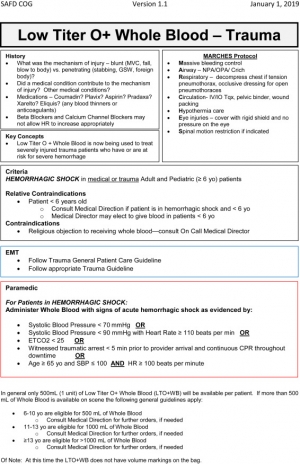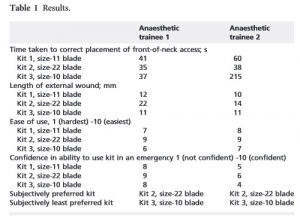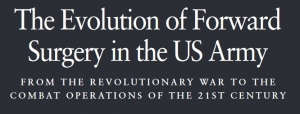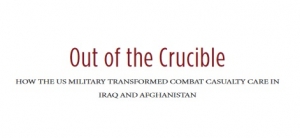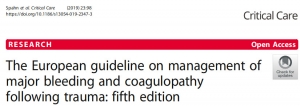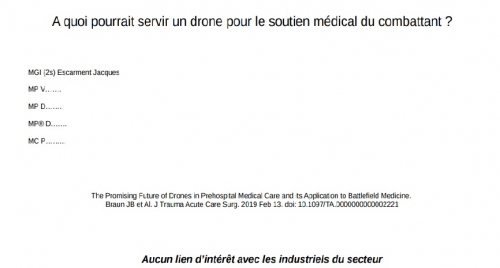30/04/2019
Sang total: Une vision US
Whole Blood in Trauma: A Review for Emergency Clinicians.
Comme quoi une roue est faite pour tourner. La même démarche chez les norvégiens en prégospitalier (1)
-------------------------------------------
BACKGROUND:
Blood products are a cornerstone of trauma resuscitation. From the historically distant battlefields of World War II through present-day conflict around the globe, whole blood (WB) has been a potent tool in the treatment of massive hemorrhagic shock. Component therapy with a targeted ratio of packed red blood cells, platelets, and plasma has previously been utilized.
OBJECTIVES:
This narrative review describes modern-day WB transfusion, its benefits, potential drawbacks, and implementation.
DISCUSSION:
The current form of stored low-titer O WB seems to be the safest and most effective solution. There are many advantages to WB, including the maintenance of coagulation factors, the lack of subsequent thrombocytopenia, and the reduction of infused anticoagulant. Several studies suggest its utility in trauma.
Most of the disadvantages of WB stem from a lack of prospective data on the topic, which are likely forthcoming. Logistical issues likely present the greatest barrier to this therapy, but an advanced prehospital protocol developed in San Antonio, Texas, has successfully overcome several of these challenges.
CONCLUSIONS:
Although stored WB holds promise, it is not without its distinct challenges, including logistical issues, which this article addresses. There are programs underway currently that demonstrate its feasibility in metropolitan areas. As demonstrated in military settings, WB is likely the ideal resuscitation fluid for civilian trauma in the prehospital and emergency department settings.
26/04/2019
Bande de compression: Ne pas les vouer aux gémonies
Comparison of Two Tourniquets on a Mid-Thigh Model: The Israeli Silicone Stretch and Wrap Tourniquet vs. The Combat Application Tourniquet.
Le succès des garrots artériels tels que le SOFT-T et le CAT ne doit pas occulter l'intérêt des bandes de compression élastiques (Bande d'Esmach, SWAT-Tourniquet, IDF Silicone Tourniquet) préconisées en médecine rurale lors d'explosion de mines antipersonnelles (1). Ce travail met en avant leur efficacité.
-----------------------------------
Introduction:
Experience from recent conflicts underlines the dramatic impact of effective tourniquet use on combat casualty mortality. Although the Combat Application Tourniquet (CAT) is replacing the silicone band tourniquets (IST; "Israeli Silicone Tourniquet") in the Israeli Defense Forces, no direct comparison was made between them. The purpose of this study is to compare the performance of the two tourniquets on a mid-thigh model.
Methods:
Participants were Israeli military recruits who previously had the military first aid course. Each participant applied both the CAT and the IST. Applications were assessed by the HapMed Leg Tourniquet Trainer, which measured the applied pressure and the time required to reach it.

Results:
IST application resulted in higher rates of effective occlusion pressure compared with the CAT (91% vs. 73.1%, p < 0.01), and a higher mean occlusion pressure (41 mmHg, p < 0.01) was recorded using the IST. Among effective attempts, application time did not differ significantly between the tourniquets.
Effect of Elapsed Time Since First Aid Course on Success Rate
| Experience More Than 1 mo (n = 15) | Experience Equal to or Less Than 1 mo (n = 63) | p-Value | |
|---|---|---|---|
| Succeeded with CAT, n (%) | 7 (46.7) | 50 (79.4) | 0.01 |
| Succeeded with IST, n (%) | 14 (93.3) | 57 (90.5) | 0.5 |
Conclusion:
The IST was superior to the CAT in producing effective occlusion pressure while not prolonging application time. These results may indicate that the IST remains a valid option for controlling mid-thigh bleeding.
| Tags : tourniquet
Fibrinogène lyophilisé: Stable 6 mois jusquà 50°c
Stability of Fibrinogen Concentrate in Human Blood Samples: An In Vitro Study
OBJECTIVES:
This study was designed to assess the stability and functional activity of fibrinogen concentrates subjected to the changes in temperature and duration observed in field conditions.
METHODS:
Fibrinogen concentrate was stored at -20°C (12 vials), 22°C (12 vials), and 50°C with 80% humidity (12 vials), for up to 6 mo. At each temperature, three vials of fibrinogen concentrate were taken out at 0, 1, 3, and 6 mo and reconstituted. On analysis days, blood samples were taken from a single healthy donor to collect plasma samples. The donor plasma was mixed with commercial fibrinogen-
RESULTS:
At 22°C for 0, 1, 3, and 6 mo, there were no significant changes observed in fibrinogen content (1,223 ± 42 mg/vial, 1,286 ± 86 mg/vial, 1,234 ± 76 mg/vial, and 1,178 ± 64 mg/vial), prothrombin time (13.5 ± 0.1 s, 13.7 ± 0.6 s, 13.3 ± 0.4 s, and 13.7 ± 0.2 s), or activated partial thromboplastin time (31.1 ± 0.2 s, 32.0 ± 0.2 s, 31.5 ± 0.2 s, and 32.0 ± 0.8 s), respectively.
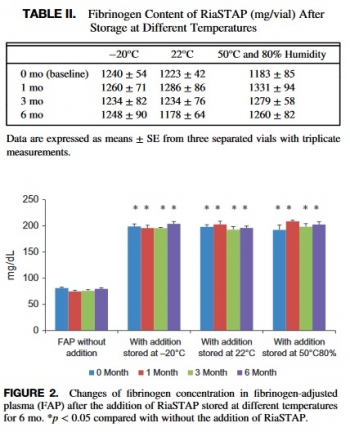
There were also no significant changes observed in any of the Fibtem measurements. Similarly, no differences were observed in these variables over time at -20°C and 50°C with 80% humidity.
CONCLUSIONS:
Fibrinogen concentrate
25/04/2019
Anesthésie PréHosp: Recos scandinave
| Tags : airway
24/04/2019
Numéro special THOR
16/04/2019
Coniotomie: Plutôt une lame de 22
Front-of-neck access technique and scalpels
Clic sur l'image pour accéder au document
| Tags : airway
FST, chirurgie et USAparticulièrement innovant
TCCC: Un écosystème spécifique
Un regard sur l'émergence des nouvelles modalités de prise en charge des blessés de guerre avec pour point d'orgue l'innovation conduite et la construction d'un écosystème complet autour de la prise en charge du blessé de guerre. Une démarche à comprendre et à bien méditer.
Clic sur l'image pour accéder au document
11/04/2019
Oxygènothérapie vs en circuit fermé: Possible
The development and evaluation of a non‐pressurised, chemical oxygen reaction generation vessel and breathing system providing emergency oxygen for an extended duration
Dingley J et Al. Anaesthesia. 2016 Dec;71(12):1464-1470.
------------------------------
Une démarche intéressante qui associe circuit d'oxygénothérapie en circuit fermé (tels que ceux employés lors d'accident de plongée, 1 ) et production d'oxygène chimique. Un produit commercial développé par la société Wenoll est disponible avec une bouteille d'O2 comprimé (2)
------------------------------
The objective was to develop a sodium percarbonate/water/catalyst chemical oxygen generator that did not require compressed gas. Existing devices utilising this reaction have a very short duration of action. Preliminary experiments with a glass reaction vessel, water bath and electronic flowmeter indicated that many factors affected oxygen production rate including reagent formulation, temperature, water volume and agitation frequency. Having undertaken full-scale experiments using a stainless steel vessel, an optimum combination of reagents was found to be 1 litre water, 0.75 g manganese dioxide catalyst, 60 g sodium percarbonate granules and 800 g of custom pressed 7.21 (0.28) g sodium percarbonate tablets. This combination of granules and slower dissolution tablets produced a rapid initial oxygen flow to 'purge' an attached low-flow breathing system allowing immediate use, followed by a constant flow meeting metabolic requirements for a minimum of 1 h duration.
10/04/2019
Saignements majeurs: 5ème révision EU
09/04/2019
Substituts au sang: Ils arrivent !
Artificial oxygen carriers- past, present and the future-a review of the most innovative and clinically relevant concepts.
--------------------------
La question du transport de l'oxygène est fondamentale pour le traumatisé sévère. La recherche de transporteurs artificiels d'oxygène sont un axe fondamental de la recherche. Il se trouve qu'une entreprise bretonne fait partie des quelques équipes travaillant sur le sujet (voir ici)
--------------------------
Blood transfusions are daily practice in hospitals. As these products are limited in availability and have various, harmful side-effects, researchers have pursued the goal to develop artificial blood components for about 40 years. Development of oxygen therapeutics and stem cells are more recent goals. Medline, clinicaltrials.gov, clinicaltrialsregister.eu and ANZCTR were searched up to November 2017 using search terms related to artificial blood products to identify new and ongoing research of the last 5 years. For already well-known products that are, however, important to the field or relevant to gain a better understanding, the reader is punctually referred to some important articles older than 5 years. This review includes not only clinically relevant substances such as heme-oxygenating carriers (HBOCs), PFOCs, stem cells and organ conservation, but also interesting pre-clinically advanced compounds depicting the pipeline of potential new products. In- depths insights into specific benefits and limitations of each substance, including the biochemical and physiological background are included. "Fancy" ideas such as Iron-based substances, O2-microbubbles, cyclodextranes or lugworms are also elucidated. To conclude, this systematic up-to-date review includes all actual achievements and ongoing clinical trials in the field of artificial blood products to pursue the dream of artificial oxygen carrier supply. Research is on the right track, but the task is demanding and challenging.
08/04/2019
CCATT: LA voie à suivre pour les EVAC
En Route Resuscitation – Utilization of CCATT to Transport and Stabilize Critically Injured and Unstable Casualties
Maddry JK et Al Mil Med. 2018 Dec 7. doi: 10.1093/milmed/usy371.
--------------------------------------
Une démarche qui prône l'emploi de spécialistes ayant une pratique régulière et avancée de la réanimation et de l'anesthésie du traumatisé pour le transport des blessés de guerre. Elle doit être rapprochée du concept des MERT-Enhanced UK.
--------------------------------------
Introduction:
The U.S. Air Force utilizes specialized Critical Care Air Transport Teams (CCATT) for transporting “stabilized” patients. Given the drawdown of military forces from various areas of operation, recent
CCATT operations have increasingly involved the evacuation of unstable and incompletely resuscitated patients from far forward, austere locations. This brief report describes unique cases representative of the evolving CCATT mission and provides future direction for changes in doctrine and educational requirements in preparation for en route combat casualty care. Methods and Materials: This case series describes three patients who required significant resuscitation during CCATT transport from austere locations between April and November 2017. Approval for this project was received from the US Air Force 59th Medical Wing Institutional Review Board as non-research.
Results:
Case 1:
CCATT was dispatched to transport patient 1 who was reported to have a head injury after a fall. Upon evaluation of the patient onboard the aircraft, it was discovered that the patient was in cardiac arrest. Cardiopulmonary resuscitation was performed during tactical takeoff with frequent combat maneuvers. The patient developed a palpable pulse after three rounds of CPR, three doses of epinephrine, and one unit of packed red blood cells. Point of care laboratory analysis demonstrated a profoundly elevated lactate level. Cyanide poisoning was a concern but there was no antidote available in the available equipment set. After delivery to a medical facility, blood samples were positive for cyanide. Over the next 2 weeks, the patient improved and was discharged home, neurologically intact.
Case 2:
Patient 2 sustained complex blast injuries and bilateral lower extremity amputations. He required early transport for continuous renal replacement therapy (CRRT). The patient received 200 units of blood products in the 24 hours prior to transport and developed renal failure, pulmonary edema, and elevated ICP. During the 7 hour flight, Patient 2 received frequent adjustments of vasopressor medications, multiple Dakins solution soaks and flushes, and 1 unit of fresh frozen plasma. He mained alive 2 months later.
Case 3:
The team was notified to collect an urgent patient with a blast lung injury and bilateral lower extremity amputations. The ground team encountered difficulty ventilating the patient. Patient 3 arrived in the back of a pickup truck accompanied by medics and being bag valve mask ventilated with a pulse oximetry reading of 65%. He was secured to the floor of the aircraft which departed within 5 minutes of arrival. An ultrasound of the lungs showed no pneumothorax. By the end of the flight, the patient’s oxygen saturation had risen to 95% and he was delivered to the emergency department in stable condition. He later passed away in the operating room due to severe blast lung and cardiac contusion.
Conclusion: This brief report demonstrates the need of CCATT in the transport of unstable patients from forward deployed locations. The Air Force has adapted and is continuing to adapt CCATT training, equipment, onboard diagnostics and therapies, and team members’ clinical skills to meet en route care combat casualty needs.
Simulation: Pas que le sauvetage au combat
Simulation Training for Operational Medicine Providers (STOMP): Impact of a Comprehensive Skills-Based Curriculum for Military General Medical Officers
Spooner MT et Al. Mil Med. 2018 Dec 4. doi: 10.1093/milmed/usy346
-----------------------------------------------
Nos camarades US ont identifié 22 gestes qu'ils considèrent comme devoir être acquis par leur médecins généralistes. Ce travail démontre l'apport de la simulation pour l'apprentissage de ce geste et milite pour un curriculum basé sur la maîtrise de gestes choisis.
-----------------------------------------------
A standardized training curriculum designed for general medical officers (GMO) titled Simulation Training for Operational Medicine Providers (STOMP) was recently developed to educate and improve GMOs’ procedural skills through directed feedback prior to assuming duties in an operational environment. This study aimed to determine the impact this novel curriculum had on GMOs’confidence levels in 21 core privileges covering eight different subspecialties while stationed at Naval Medical Center Portsmouth (NMCP).
A cohort study from 2015 to 2017 was designed to address our specific aim to examine if the implementation of the STOMP curriculum increased GMOs’ confidence levels. Fifty-seven participants enrolled in the study. The GMO case group completed the STOMP curriculum (n = 22), while the control or GMO self-study group (n = 35) did not complete the curriculum. Six months after starting clinical practice at NMCP, both groups completed an online survey that assessed their confidence level in performing each core privilege using a 5-point Likert scale. Scores were analyzed using a Wilcoxon Mann–Whitney test. Research data were derived from an approved Naval Medical Center, Portsmouth, Virginia IRB, protocol number: NMCP.2016.0010.
Participants demonstrated a statistically significant increase in self-rated confidence scores (p < 0.05) in nine core privilege skills: punch biopsy, shave biopsy, excisional biopsy, removal of otic foreign body, removal of nasal foreign body, removal of ocular foreign body, tonometry, incision and drainage of a thrombosed hemorrhoid, and reduction of simple closed fractures and dislocations.

These findings suggest that a novel and recently developed standardized simulation training curriculum entitled STOMP improves the confidence levels of early career physicians’ in several primary care procedural skills and is an ideal adjunct to traditional lecture-based teaching prior to independent practice in a primary care environment.
07/04/2019
ControlCric: Plutôt à éviter
Necessity to depict difficult neck anatomy for training of cricothyroidotomy: A pilot study evaluating two surgical devices on a new hybrid training model.
BACKGROUND:
Everyone dealing with airway emergencies must be able to accomplish cricothyroidotomy, which cannot be trained in real patients. Training models are necessary.
OBJECTIVE:
To evaluate the suitability of a hybrid training model combining synthetic and porcine parts to depict variable neck anatomy.
DESIGN:
Model-based comparative trial.
SETTING:
Armed Forces Hospital Ulm, Germany, August 2018.
INTERVENTION:
On four anatomical neck variations (long slim/long obese/short slim/short obese) we performed two surgicalrapproaches to cricothyroidotomy (SurgiCric II vs. ControlCric).
PARTICIPANTS:
Forty-eight volunteers divided into two groups based on their personal skill level: beginners group and proficient performers group.
MAIN OUTCOME MEASURES:
Time to completion was recorded for each procedure. Once the operator had indicated completion, the correct anatomical tube placement was confirmed by dissection and structures were inspected for complications. Primary outcomes were successful tracheal placement of an airway tube and time needed to achieve a patent airway. Secondary outcome was assessment of complications.
RESULTS:
Overall, 384 procedures were performed. Median time to completion was 74 s. In total, 284 procedures (74%) resulted in successful ventilation. Time to completion was longer in short obese than in long slim and the risk of unsuccessful procedures was increased in short obese compared with long slim. Even if ControlCric resulted in faster completion of the procedure, its use was less successful and had an increased risk of complications compared with SurgiCric II. Proficient performers group performed faster but had an increased risk of injuring the tracheal wall compared with beginners group.
CONCLUSION:
Participants had difficulties in performing cricothyroidotomy in obese models, but various and difficult anatomical situations must be expected in airway management and therefore must be taught. A new hybrid model combining porcine and synthetic materials offers the necessary conditions for the next step in training of surgical airway procedures.
ControlCric: Plutôt à éviter
Necessity to depict difficult neck anatomy for training of cricothyroidotomy: A pilot study evaluating two surgical devices on a new hybrid training model.
BACKGROUND:
Everyone dealing with airway emergencies must be able to accomplish cricothyroidotomy, which cannot be trained in real patients. Training models are necessary.
OBJECTIVE:
To evaluate the suitability of a hybrid training model combining synthetic and porcine parts to depict variable neck anatomy.
DESIGN:
Model-based comparative trial.
SETTING:
Armed Forces Hospital Ulm, Germany, August 2018.
INTERVENTION:
On four anatomical neck variations (long slim/long obese/short slim/short obese) we performed two surgicalrapproaches to cricothyroidotomy (SurgiCric II vs. ControlCric).
PARTICIPANTS:
Forty-eight volunteers divided into two groups based on their personal skill level: beginners group and proficient performers group.
MAIN OUTCOME MEASURES:
Time to completion was recorded for each procedure. Once the operator had indicated completion, the correct anatomical tube placement was confirmed by dissection and structures were inspected for complications. Primary outcomes were successful tracheal placement of an airway tube and time needed to achieve a patent airway. Secondary outcome was assessment of complications.
RESULTS:
Overall, 384 procedures were performed. Median time to completion was 74 s. In total, 284 procedures (74%) resulted in successful ventilation. Time to completion was longer in short obese than in long slim and the risk of unsuccessful procedures was increased in short obese compared with long slim. Even if ControlCric resulted in faster completion of the procedure, its use was less successful and had an increased risk of complications compared with SurgiCric II. Proficient performers group performed faster but had an increased risk of injuring the tracheal wall compared with beginners group.
CONCLUSION:
Participants had difficulties in performing cricothyroidotomy in obese models, but various and difficult anatomical situations must be expected in airway management and therefore must be taught. A new hybrid model combining porcine and synthetic materials offers the necessary conditions for the next step in training of surgical airway procedures.
| Tags : airway
Un drone pour le blessé de guerre ? Plutôt plusieurs
| Tags : drone
05/04/2019
ISR: Ket/Celo SANS autre chose
Does the addition of fentanyl to ketamine improve haemodynamics, intubating conditions or mortality in emergency department intubation: A systematic review
04/04/2019
Un genou: Fait pour comprimer !
Martial arts technique for control of severe external bleeding.
Slevin JP et Al Emerg Med J. 2019 Mar;36(3):154-158. doi: 10.1136/emermed-2018-207966.
OBJECTIVES: Haemorrhage control is a critical component of preventing traumatic death. Other than the battlefield, haemostatic devices, such as tourniquets or bandages, may not be available, allowing for significant avoidable blood loss. We hypothesised that compression of vascular pressure points using a position adapted from the martial art of Brazilian Jiu-Jitsu could be adapted to decrease blood flow velocity in major extremity arteries.
METHODS: Knee mount compression was applied to the shoulder, groin and abdomen of healthy adult volunteer research subjects from Seattle, Washington, USA, from March through May 2018. Mean arterial blood flow velocity (MAV) was measured using ultrasound in the brachial and femoral arteries before and after compression. A MAV decrease greater than 20% with compression was deemed clinically relevant.
RESULTS: For 11 subjects, median (IQR) MAV combining all anatomical locations tested was 29.2 (34.1, 24.1) cm/s at baseline and decreased to 3.3 (0, 19.1) cm/s during compression (Wilcoxon p<0.001). MAV was significantly decreased during compression for each individual anatomical position tested (Wilcoxon p≤0.004). Per cent (95% CI) MAV reduction was significantly greater than 20% for shoulder compression at 97.5%(94% to 100%) and groin compression at 78%(56% to 100%), but was not statistically greater for abdominal compression at 35%(12% to 57%). Complete vessel occlusion was most common with compression at the shoulder (73%), followed by groin (55%) and abdomen (9%) (χ² LR, p=0.018).
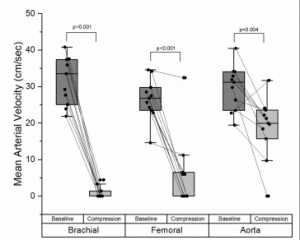
CONCLUSION: The Brazilian Jiu-Jitsu knee mount position can significantly decrease blood flow in major arteries of the extremities. This technique may be useful for bleeding control after injury.
01/04/2019
Oxsealife: LE cristalloïde de demain ?
Blood transfusion is given according to haemoglobin thresholds aimed at restoration of arterial oxygen-carrying capacity. Patient survival after severe haemorrhagic shock depends on restoration of microvascular perfusion, tissue oxygen delivery, endothelial function and organ integrity. We investigated a novel crystalloid fluid designed for tissue oxygen delivery, Oxsealife® , with components that generate microvascular nitric oxide and scavenge reactive oxygen species generated during ischaemia-reperfusion injury. The amount of dissolved oxygen in blood progressively increased during step-wise in vitro haemodilution with this fluid, suggesting that the oxygen solubility coefficient of blood is dynamic, not static. We performed a pilot safety and efficacy study to compare resuscitation with this novel crystalloid vs. whole blood transfusion in a swine haemorrhagic shock model with animals bled to an arterial lactate oxygen debt target. Despite contributing no haemoglobin, viscosity nor oncotic potential, resuscitation with Oxsealife after severe haemorrhagic shock restored central haemodynamic parameters comparable to stored allogeneic blood transfusion. Tissue perfusion, oxygenation and metabolic outcomes were equivalent between treatment groups. Increased consumption of bicarbonate in animals given Oxsealife suggested greater capillary recruitment and enhanced clearance of acidic tissue metabolites. Serum markers of organ function, animal activity during recovery and histological analysis of tissue morphology and endothelial glycocalyx integrity confirmed functional recovery from haemorrhagic shock. We conclude that recovery of tissue oxygen delivery and organ function after haemorrhagic shock may not be dependent on treatments that increase haemoglobin levels. Oxsealife shows promise for treatment of severe haemorrhagic shock and may reduce the requirement for allogeneic blood products.

